
As a child, you probably looked forward to becoming an adult so you could make your own decisions. It wasn’t fair that your parents could tell you when to go to bed, what you had to eat, and that you had to take a bath every day!
As an adult, you probably crave that same control. Unfortunately, many of us now report to a different master: money. This new boss controls everything from where we live to whether we can go on a much-needed vacation.
Pay-per-mile insurance is about more than savings — it’s about control. As a Metromile customer, you will only pay for the miles you drive, and that amount is up to you! But insurance is just one piece of your financial puzzle, and greater control of the rest is also within your reach. Here’s how to get started:
Take stock of your finances
When fixing a flat tire, you don’t just randomly slap a patch on it and hope you covered the hole. You have to inspect the tire and identify the issue so you can figure out how to fix it.
It’s the same with your finances. If you want to take control, the first step is assessing the situation by taking stock of where your money is coming from and where it’s going.
This might be the scariest step, but it’s the most important, as you’ll use this information to make a plan. So take a deep breath, log into your financial accounts, and jot down the following information:
- All of your income. This includes your primary salary, any side hustles, etc.
- All of your debts. Make sure you total up everything — credit card debt, student loans, auto loans, medical debt — the works. Conveniently ”forgetting” to include debts so your total sum looks smaller will only hurt you later when the numbers don’t add up.
While you’re at it, check your credit so you know how other people are assessing you. Your credit score and history can impact everything from whether you get that dream apartment to how much you’ll pay for car insurance, so it’s important to keep track of. You can pull your credit report for free from each of the credit bureaus every year.
Make a plan
While winging everything might’ve worked for Harry Potter, it probably won’t help you win the war against debt. You need a good plan if you want to take control.
In the financial world, plans usually take shape in the dreaded “b” word: budget. Don’t worry: a budget isn’t as scary as it sounds. John Maxwell explains that a budget is simply “telling your money where to go instead of wondering where it went.” It’s also nothing to be ashamed about — in fact, the one thing most millionaires have in common is that they make a budget.
First things first: have a goal. Maybe that’s paying off all your debt, saving a certain amount of money this year, or buying a new car. This will help you focus when you’re tempted to stray.
Secondly, create a plan for every dollar. To simplify things, break your expenses up into categories. For example, you may want to allocate 50% of your after-tax income to necessities (rent, food, transportation, etc.), 20% to wants (your favorite drink at Starbucks, date night, etc.), and 30% to savings and debt repayment. There are some fantastic tools to help on this front like YNAB (You Need a Budget).
Next, track everything. This step is essential if you want to create a realistic budget and stick to it. It doesn’t matter whether you use an app or record everything manually, you just need to be able to glance at it and know how you’re doing. Check in several times each month and adjust your spending pace as necessary.
Finally, keep adjusting. No one expects you to spend and save the same amount each month. Things happen; give yourself some flexibility and don’t beat yourself up if you occasionally go off-track.
Bottom line
When it comes to taking charge of your finances, getting started is the hardest part. Just remember: it’ll all be worth it when you finally have control over your life again. In a future article, we’ll go over practical ways to set yourself up for financial success in the future.
– – –
Jenna Lee is a content marketer, Oxford comma enthusiast, and cat lover living in the Bay Area.








